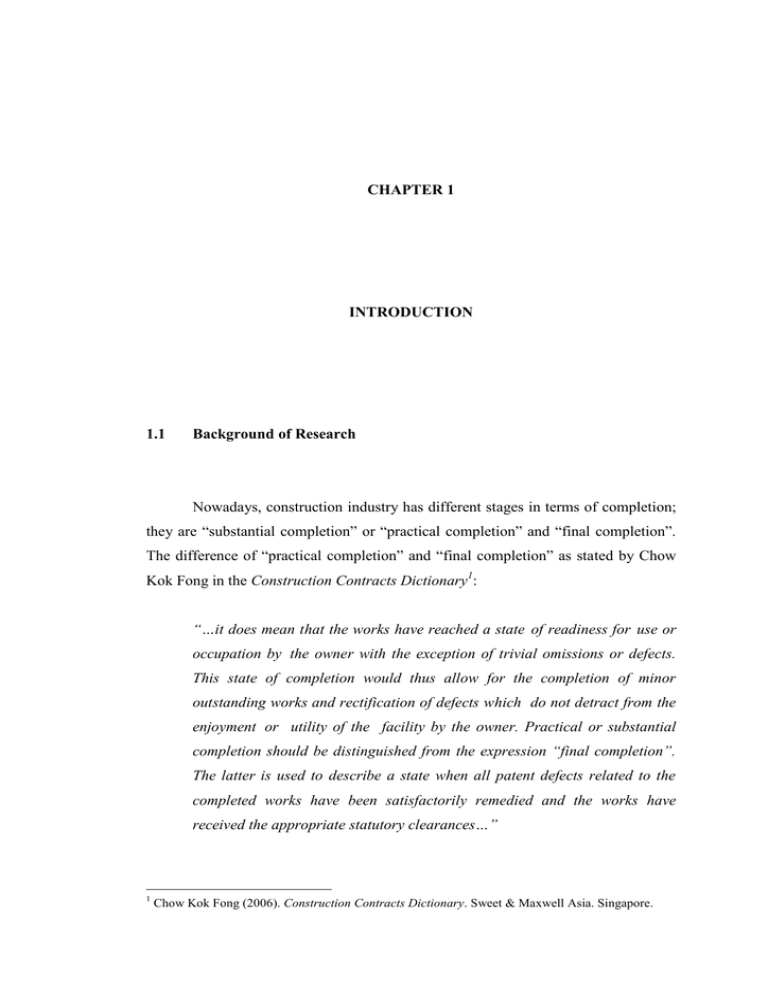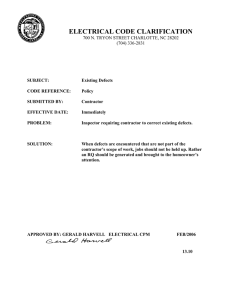1 Nowadays, construction industry has different stages in terms of completion;
advertisement

1 CHAPTER 1 INTRODUCTION . 1.1 Background of Research Nowadays, construction industry has different stages in terms of completion; they are “substantial completion” or “practical completion” and “final completion”. The difference of “practical completion” and “final completion” as stated by Chow Kok Fong in the Construction Contracts Dictionary1: l “…it does mean that the works have reached a state of readiness for use or . l . l occupation by the owner with the exception of trivial omissions or defects. l This state of completion would thus allow for the completion of minor outstanding works and rectification of defects w hich do not detract from the . . l enjoyment or utility of the facility by the owner. Practical or substantial l l l completion should be distinguished from the expression “final completion”. The latter is used to describe a state when all patent defects related to the completed works have been satisfactorily remedied and the works have received the appropriate statutory clearances…” 1 Chow Kok Fong (2006). Construction Contracts Dictionary. Sweet & Maxwell Asia. Singapore. 2 When the works is awarded with practically completed, it brings some consequences related to contract matter. Among them are, it marks the end of l contractor‟s liabilities in respect of his contractual obligations except for his liability l . to make good defect which occur during the Defect Liability Period (such as set out l . l l . l at clause 15.5 PAM 2006 Contract), the contractor‟s license to occupy the site comes to an end (such as set out at clause clause 15.2 PAM 2006 Contract) and the contractor‟s liability to pay or to allow to the em ployer deduct liquidated damages . . ends (such as set out at clause clause 22.1 PAM 2006 Contract)2. The consequences of the works have been awarded with practically completed can also affecting another contracts, such as triggering the sale and purchase agreement in conveyancing transactions. The purchaser then has to make . any payment to the developer regarding the purchase of the premises. With practical completion brings so many consequences, the contract administrator needs to ensure that the works really deserve to be awarded with practically completed. When the contractor feels that his works already can be awarded with practically completed, the contract administrator will do some tests on completion/ site inspections where one of the tests is related to find out whether there are any defects. One of the purposes of this test is to observe whether the defects are major defects or merely minor. When it found from the test/inspection that there are some minor defects in the works, contract administrator, however, still can issue a Certificate of Practical l Completion. In H.W Nevill (Sunblest Ltd) v. William Press & Son Ltd3, Judge Newey l . l said: “…I think that the word „practically‟ in Clause 15(1) [JCT „63] gave the l . l l architect a discretion to certify that William Press had fulfilled its obligation . l l . under Clause 21(1), where minor or de minimis work had not been carried l . l . out. But that if there were any patent defects in what William Press had done . l the architect could not have given a certificate of practical completion…” . 2 3 . l Sundra Rajoo et.al (2010). The PAM 2006 Standard Form of Building Contract. Lexis Nexis. p.233 (1981) 20 BLR 78 3 One of the reasons why practical completion can be awarded even though . there are minor defects is because minor defects should be regarded as normal condition in practical completion stage. It is almost a certainty there will not be a single construction project can be completed perfectly without any defective works. It is because construction projects are so complex, involving many parties, materials with specific specifications, and wide range of construction works, thus it is almost impossible to finish the project perfectly as the detail drawings and specification without any single mistaken works. In the c ase of Emson Eastern Ltd v. E.M.E. . l Developments Ltd4, Judge John Newey said: “building construction is not like the manufacture of goods in a factory. The l l . l size of the project, site conditions, use of many materials and employment of l . l various types of operatives make it virtually impossible to achieve the same l . l l degree of perfection as can a manufacturer. It must be a rare new building l . in which every screw and every brush of paint is absolutely correct .” . 1.2 l Problem Statement As described previously, practical . completion can be awarded notwithstanding there may be works of minor defects. The contract administrator has discretion to consider whether or not practical completion can be awarded if there are defective works on minor nature. However, the awarded of practical completion when there are minor defects in the contractor‟s works, can bring into situations where the awarding being challenged. Sundra Rajoo (2006) said5: “…the use of the adjective „minor‟ for the outstanding works and defects introduces another foreseeable area of disputes and possibly abuse in practices…” 4 5 (1991) 55 BLR 114 Sundra Rajoo et.al., op.cit. p.232 4 Such concern may occur in conveyancing transactions. A developer may want practical completion to be certified quickly notwithstanding there are some defective or incomplete works, since the issuance of CPCs can trigger Sale and Purchase Agreement between the developer and purchaser. Once the CPCs is issued, developer can ask the financial institutions from which the buyers have taken loans l l l to release the progress payments faster to the developer based on the contract l l l l administrator‟s certificate of completion6. An example of how minor defects in practical completion stage can bring dispute can be seen in next cases. In case of Uniphone Telecommunications Bhd v Bridgecon Engineering Sdn Bhd & Anor7, the CPC was being challenged by the purchaser. According to the respondents, the defects were not serious in nature. In other words, the defects were only minor or cosmetic in nature. The appellant, on the other hand, contends that the incomplete works and defects were serious and substantial. Thus, to the appellant, the purported CPC was issued “ostensibly to meet the date set in the said assignment”. In other words, the issuance of the CPC was not bona fide. In Walter Lilly & Co Ltd v Mackay and another company8, the employer wanted to create what they called as "dream home" for themselves and their two children. To ensure their “dream home” was built perfectly, the employer then listing out some list of hundreds minor defects, and argued that the works from can be awarded with practically completed only when the minor defects has been rectified. Therefore, the questions that need to be answered and be the foundation of this research are does the works can be regarded with practically completed when there are any minor defects? What are the circumstances that make the practical completion can or cannot be awarded when there are minor defects? Can practical completion be delayed if the works have minor defects? 6 Airing Woes Of House Buyers. (2001, 30 June). The Star. p.19 [2011] 5 MLJ 875 8 [2012] EWHC 1773 (TCC) 7 5 1.3 Objective of Research Based on the problem statements that have been described previously, the objective of this research is to identify the circumstances when minor defects can lead to delayed the awarded of practical completion or make the awarding of practical completion become invalid. 1.4 Scope and Limitation of Research Based on the objective, the approach adopted in this research is based on case law which covers the following areas: 1. The area of research is within construction contracts. 2. Court cases referred in this research are collected through the web of Lexis Nexis and another sources from the web. Only the construction cases from commonwealth jurisdiction are used for this research. 1.5 Significant of Research l This research is useful to guideline the employer, contract administrator, and l contractor to understand what circumstances that minor defects can lead to delayed the awarded of practical completion or make the awarding of practical completion become invalid. 6 This research also may assist especially for contract administrator to increase his awareness when giving his discretion relating to issuance of CPC when there are minor defects in the works. 1.6 Research Process and Methods of Approach To make a proper research, it is important to prepare a research process methodology on how to gain more knowledge on the research‟s issue, to collect data, and how to analysis the data. In order to achieve the objective of this research, it involves extensive literature review. Figure 1.1 shows the research methodology established for the research. 1.6.1 First Stage - Identify the Issue l l Initially, on the first stage, the research process begins by getting as much knowledge about the issue through extensive reading of some literatures. It involve general reading on variety sources of published materials such as seminar papers, . journals, articles, previous research report, newspapers, magazines and electronic . . resources through the W orld Wide Web and online databases from library of . Universiti Teknologi Malaysia, PSZ‟s website. 7 1.6.2 Second Stage - Literature Review . Literature review is the stage where the research title is further explained and . discussed incorporating various types of data and information that are gathered through books, articles, magazines, journals, newspapers. Besides of these sources, reported court cases from different sources such as Malayan Law Journal is referred too. This phase is vital to support and strengthen the research before the research proceeded to other stages. 1.6.3 Third Stage - Data Collection In order to be able to make an analysis, it required data collections in the form of legal cases that have occurred. Most of the data obtain from university‟s library online e-database via the Lexis-Nexis website. The other sources such as articles, journals, textbooks and related websites, are also studied and analysed to complement the main sources. 1.6.4 Fourth Stage - Data Analysis Next stage is, after all the required data have been collected, documentary analysis. It is adopted as a means of analysis. The relevant law cases that have been collected is carefully reviewed, with take special attention on the facts of the case, issues and judgments that relate to the objective of the research. 8 1.6.5 Final Stage - Recommendations and Conclusion After the discussions have been made, the research findings and conclusion from the analysis are being drawn to answer the problem statements and fulfill the objective of this research. 9 Establish area of study Define clearly the background of the research, problem that needs to be researched FIRST STAGE Defined Objective and Scope of Research Identify the objective and scope of the research clearly by gain more knowledge reading from some literatures Literature Review SECOND STAGE Books, journals, articles, and cases related from Lexis-Nexis Legal Database Data Collection THIRD STAGE Sources of Data Court cases from MLJ and other commonwealth jurisdiction Journals and Articles Academic books FOURTH STAGE Method of data collection Documentary Data Analysis Analysis courts’ decision and provision in standard forms FINAL STAGE Conclusions and Recommendations Figure 1.1: Research Methodology 10 1.7 Organization of Thesis . The thesis consists of five chapters. The brief descriptions of each chapter . l l are as follows: 1.7.1 Chapter 1: Introduction . Chapter 1 is the introduction chapter for the research. It contains the background of the research, the problem statement, the objective of the research, . scope and limitation of research, the significance of research, methodology and the l . l organization of thesis chapters. 1.7.2 Chapter 2: Practical Completion This chapter explores the literal meaning and the principles of practical l l l completion that has been described by some authors, by judicial decisions and as l described in the standard form of construction contract. It reviews the requirements and procedures so the works can be awarded with practically completed. This chapter also provides an understanding on the importance and consequences of practical completion. 11 1.7.3 Chapter 3: Minor Defects This chapter seeks to establish an understanding of defects, the meaning and types of defects, through a literature review of some books, published research and case law. The focus of this chapter is to provide an understanding particularly on minor defects and to highlight the position of minor defects in construction industry. 1.7.4 Chapter 4: Analysis and Results This chapter analyses the data that have been collected before. It discusses the judicial decisions that have been made by the court regarding the presence of minor defects in practical completion stage. Attempts are made to state the legal principle there from. This chapter seeks as much as possible to find answers to questions as set out in the first chapter under problem statement. 1.7.5 Chapter 5: Conclusion This chapter presents the summary of research findings and conclusion to fulfill the objective of this research. It also addresses some research constraints that encounter during the preparation of this research.





